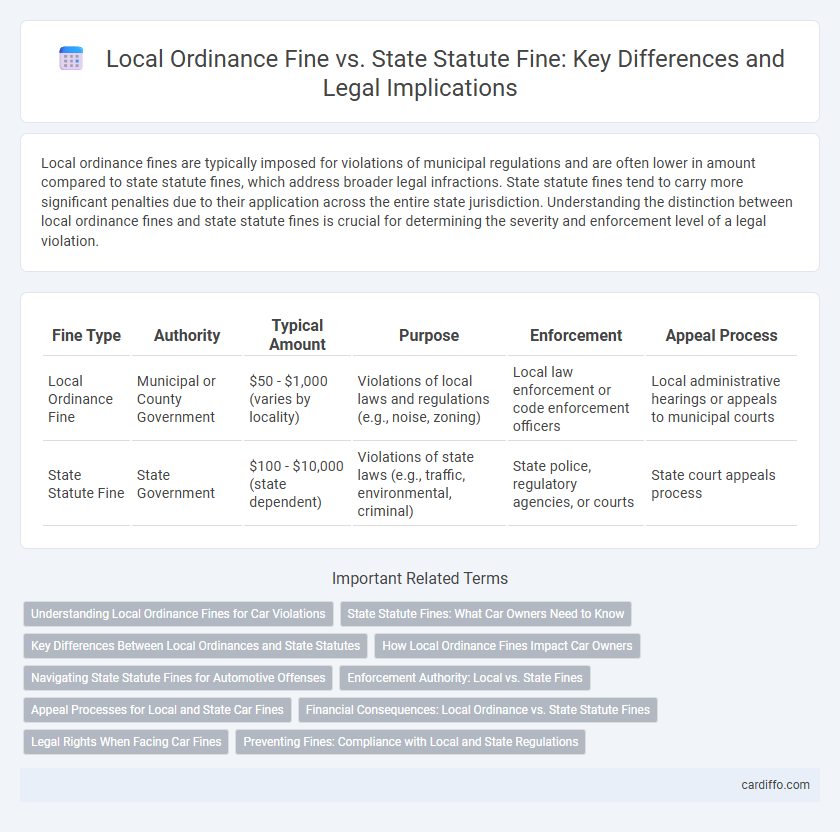Local ordinance fines are typically imposed for violations of municipal regulations and are often lower in amount compared to state statute fines, which address broader legal infractions. State statute fines tend to carry more significant penalties due to their application across the entire state jurisdiction. Understanding the distinction between local ordinance fines and state statute fines is crucial for determining the severity and enforcement level of a legal violation.
Table of Comparison
| Fine Type | Authority | Typical Amount | Purpose | Enforcement | Appeal Process |
|---|---|---|---|---|---|
| Local Ordinance Fine | Municipal or County Government | $50 - $1,000 (varies by locality) | Violations of local laws and regulations (e.g., noise, zoning) | Local law enforcement or code enforcement officers | Local administrative hearings or appeals to municipal courts |
| State Statute Fine | State Government | $100 - $10,000 (state dependent) | Violations of state laws (e.g., traffic, environmental, criminal) | State police, regulatory agencies, or courts | State court appeals process |
Understanding Local Ordinance Fines for Car Violations
Local ordinance fines for car violations typically vary by municipality and are often lower than state statute fines but can accumulate with repeated offenses. These fines address minor infractions such as parking violations, expired registrations, and local traffic rules, reinforcing community safety standards. Understanding the difference between local ordinance fines and state statute fines is essential for motorists to ensure compliance and avoid escalating penalties.
State Statute Fines: What Car Owners Need to Know
State statute fines impose standardized penalties on car owners for violations such as speeding, illegal parking, and equipment defects, often higher than local ordinance fines to ensure consistent enforcement across jurisdictions. These fines are authorized by state law and can include additional consequences like points on a driver's license or increased insurance rates. Understanding state statute fines is crucial for car owners to avoid costly penalties and comply with uniform traffic regulations statewide.
Key Differences Between Local Ordinances and State Statutes
Local ordinance fines are imposed by municipal governments and typically address community-specific issues such as zoning violations or noise regulations, with penalties varying widely between jurisdictions. State statute fines arise from laws enacted by the state legislature, covering broader legal areas like traffic violations or criminal offenses, and often have uniform penalties across the state. Enforcement authority, scope, and the legislative body responsible for the laws create significant distinctions between local ordinance fines and state statute fines.
How Local Ordinance Fines Impact Car Owners
Local ordinance fines directly affect car owners by imposing specific penalties for violations such as parking infractions, noise disturbances, or local traffic rules that may differ from state statutes. These fines often vary in amount and enforcement severity depending on the municipality, influencing drivers' compliance and financial liabilities within city limits. Understanding local ordinance fines is crucial for car owners to avoid unexpected charges that can accumulate independently from state statute penalties.
Navigating State Statute Fines for Automotive Offenses
Navigating state statute fines for automotive offenses requires understanding specific penalties established by state law, which often surpass local ordinance fines in severity and scope. State statutes typically impose standardized fines for violations such as speeding, DUI, and equipment violations, ensuring uniform enforcement across all municipalities within the state. Awareness of these fines helps drivers prepare for potential legal and financial consequences beyond local jurisdictions.
Enforcement Authority: Local vs. State Fines
Local ordinance fines are typically enforced by municipal or county authorities, such as city police departments or code enforcement offices, focusing on violations within their jurisdictional boundaries. State statute fines fall under the enforcement authority of state-level agencies, including state police or specialized regulatory boards, with broader jurisdiction that covers the entire state. The distinction in enforcement authority impacts the procedural handling, penalty collection, and legal recourse available for the respective fines.
Appeal Processes for Local and State Car Fines
Local ordinance fines typically offer a more streamlined appeal process through municipal courts, often requiring a written request or in-person hearing within a specified timeframe. State statute fines usually involve a more formal appeal system, including the option to challenge the fine in state courts or through administrative agencies with defined procedural rules. Understanding the specific appeal deadlines and documentation requirements for both local and state fines is crucial to effectively contesting and potentially reducing penalties.
Financial Consequences: Local Ordinance vs. State Statute Fines
Local ordinance fines typically involve lower financial penalties compared to state statute fines, reflecting the limited jurisdiction and scope of local governments. State statute fines generally impose higher monetary consequences due to broader legal authority and the potential severity of violations. Financial consequences from state statutes often include additional court fees and mandatory restitution, increasing the total cost beyond the base fine amount.
Legal Rights When Facing Car Fines
Legal rights when facing car fines vary depending on whether the fine originates from a local ordinance or a state statute. Local ordinance fines often involve municipal courts with specific procedures, while state statute fines are handled by state courts with broader authority. Understanding the jurisdiction and applicable laws ensures proper defense strategies and protection of due process rights.
Preventing Fines: Compliance with Local and State Regulations
Preventing fines requires strict adherence to both local ordinances and state statutes, which often vary in scope and penalties. Local ordinance fines typically address specific community concerns such as zoning, noise, and property maintenance, while state statute fines cover broader legal regulations including safety standards and commercial compliance. Regularly reviewing updated municipal codes and state laws, along with proactive communication with regulatory authorities, ensures effective compliance and minimizes the risk of costly penalties.
Local ordinance fine vs state statute fine Infographic

 cardiffo.com
cardiffo.com